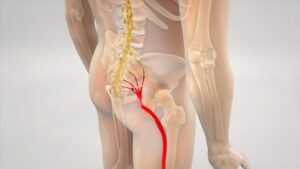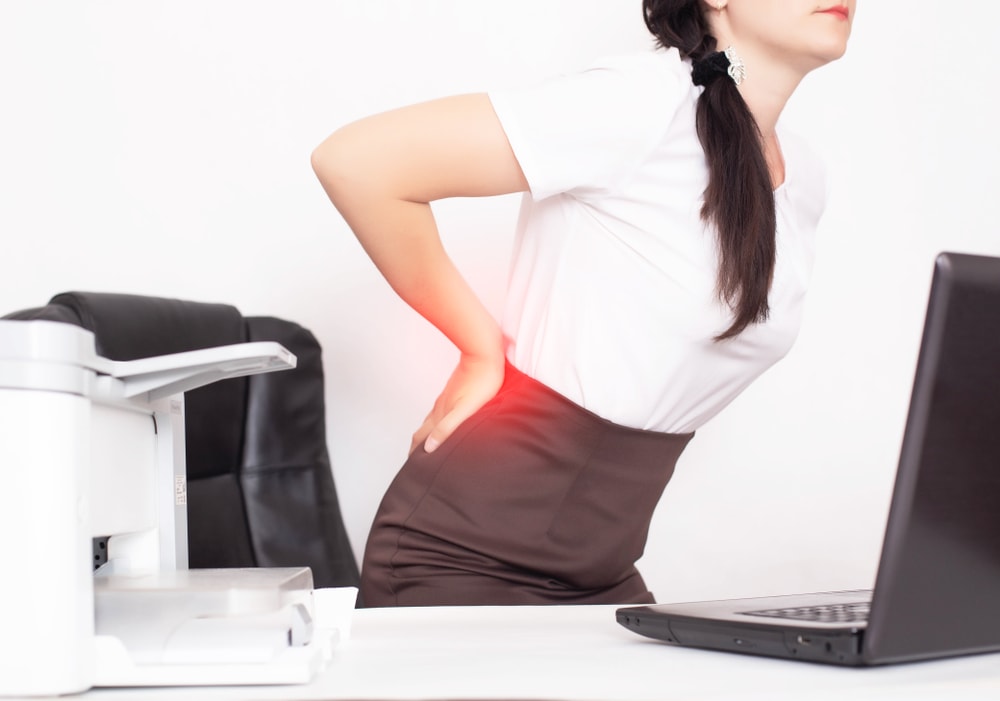The sciatic nerve is a nerve that is derived from the low back after the merging of spinal nerve roots L4-S2 from the lumbosacral plexus. It travels from the low back down through the posterior hip through the sciatic notch and continues down the posterior thigh to just above the posterior knee.
Pain from this nerve can cause a cascade of symptoms such as a deep ache/pain in the buttock region, numbness or tingling down the posterior leg, weakness of the leg muscles (particularly the hamstrings), and loss of sensation to sharp and/or dull sensations.

Sciatic Nerve
Causes of sciatic nerve pain
Sciatic nerve pain often begins with repetitive movements or prolonged positions. The most common cause is motion segment dysfunctions of the lumbar spine, which increase neuromechanosensitivity and lead to a lower threshold of tolerance for compression in the peripheral nerves down the leg.
Some causes of lumbar derived motion segment issues could include:
- Central or lateral spinal stenosis
- Disc protrusion/prolapses
- Peripheral nerve root compression secondary to hypertonicity of the posterior hip musculature
- Inflammation and swelling from arthritis
In certain cases,
- Iliopsoas
- Gluteal and pelvic abscesses
- Vascular problems due to increased blood volume in the spine during the late stages of pregnancy
- Trauma such as hamstring injuries/avulsions or compression of the adjacent sciatic nerve secondary to edema or inflammation formed around the affected aspect of the muscle tissue.
An in-depth clinical examination to identify where the symptoms are derived from will include neurological testing such as motor weakness, sensory changes and deep tendon reflexes (specifically from L4-S2). Neural provocation tests such as the straight leg raise, crossed straight leg raise and SLUMP tests may aid in providing further differentiation of a central vs. peripheral source to the pain.
Treatments for sciatic nerve pain
Interventionally, thermal modalities such as heat/ice often placed on affected areas for 20 minutes every 2-3 hours may prove to be beneficial. Physiotherapy treatment will most likely include a multi-modal approach including manual therapy treatment to lumbar spine motion segments.
Mechanical traction may aid in alleviating the radicular symptoms. Other passive modalities such as intramuscular stimulation and/or acupuncture to the lumbar spine, posterior hip and leg may also aid in symptom management. Electrophysical modalities such as Interferential Current or TENS units may yield similar reductions in symptoms. The integration of neural mobilization techniques should lead to a reduction in radicular symptoms and can be integrated with trunk coordination, strengthening and endurance exercises to reduce low back pain and disability.
Centralization and directional preference exercises and procedures often called “repeated movements” can promote the reduction of symptoms in patients with sciatic driven symptoms from the lumbar spine. Patient education and counselling can be used to advocate that the client remains active. It will explain the anatomical and structural inherent strength of the human spine and include neuroscience that explains pain perceptions, and the overall favourable prognosis of low back pain with a multimodal approach.
Early resumption of normal or vocational activities should be encouraged, even when still experiencing pain. All of these interventions will have the ultimate goal of improving activity levels, not just pain relief.
In cases where symptoms persist, a referral to interventional radiology for consideration of candidacy for a selective nerve root block or other interventional techniques may prove to provide short term benefit.





